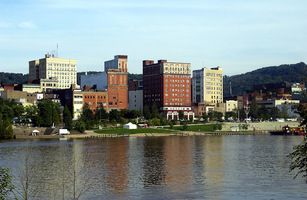 | Back to e-WV
| Back to e-WV
 The West Virginia Encyclopedia
The West Virginia Encyclopedia
 | Back to e-WV
| Back to e-WV
 The West Virginia Encyclopedia
The West Virginia Encyclopedia

Wheeling lies 57 miles below Pittsburgh on the Ohio River. The manufacturing and commercial center of the Northern Panhandle and the county seat of Ohio County, Wheeling stretches along a narrow valley on the east bank of the Ohio, around and over the neighboring foothills, and westward across Wheeling Island. The valley of Wheeling Creek eastward is the ‘‘out-the-Pike’’ area, with its residential suburbs and Oglebay and Wheeling parks.
There are signs of long prehistoric habitation in this part of the Ohio Valley, including the impressive Adena mound at nearby Moundsville. The name ‘‘Wheeling’’ predates white settlement, deriving from a native word understood to mean ‘‘place of the head’’ or ‘‘place of the skull.’’ On Wheeling Creek a white man was scalped, decapitated, and his head impaled at the creek mouth to deter further visitors.
French explorers in 1739 and 1749, the surveyor Christopher Gist in 1751, and George Washington in 1770 all came to eye the rich river valley. Celoron de Blainville buried a lead plate for the French at the mouth of Wheeling Creek in 1749. The first organized white settlement, initially called Zanesburg, dates from 1769, when Ebenezer, Silas, and Jonathan Zane emigrated from the South Branch Valley in the present Eastern Panhandle. The Zanes, their slaves, and their friends, including the Wetzels, Caldwells, Shepherds, and McCollochs, initially populated the Wheeling area.
In 1774, with the murder of Chief Logan’s family, a general Indian uprising evolved into Dunmore’s War, and soldiers from Fort Pitt built Fort Fincastle on a bluff near the mouth of Wheeling Creek, renamed Fort Henry for Governor Patrick Henry in 1776. Although besieged in 1777 and in 1782, when Betty Zane made her legendary gunpowder run, the community survived and prospered. In 1796, Ebenezer Zane blazed his famous trace to Maysville, Kentucky, making Wheeling an early commercial center for western pioneers. In 1797, Wheeling became the county seat, in 1806 it was chartered as a town, and in 1836 it was incorporated as a city.
In 1818, the arrival of the National Road spurred growth and fostered such enterprises as boat building, iron manufacturing, glassmaking, provision stores, blacksmith shops, hotels, and taverns. Bands of enslaved people arrived, leading to a slave auction block at 10th Street and also to Underground Railroad activity. Wheeling became known as the Nail City because of its enormous output of cut nails at such factories as the La Belle Ironworks. By 1831, Wheeling was declared an inland port of entry. A handsome U.S. Custom House, now preserved as West Virginia Independence Hall, was built in 1859.
Wheeling boasted very early telegraphs, waterworks, gas lights, and electricity. It had free public schools in 1849, a hospital in 1850, and a library in 1852. In 1849, Wheeling built the first bridge across the Ohio River, which was for many years the longest suspension bridge in the world. In January of 1853, the Baltimore & Ohio Railroad reached the city.
With secession and the Civil War, Wheeling hosted the meetings that led to the creation of the unionist Reorganized Government of Virginia and then to the birth of the new state of West Virginia. Wheeling was the first capital for both. Though divided in its sentiments, Wheeling had important Union facilities during the Civil War, including Camp Carlile, a recruitment and training center; an army general hospital; and a military prison, the Atheneum.
After the war, Wheeling maintained its commercial prominence, jumping from 14,083 people in 1860 to 30,737 in 1880. The city had long offered plentiful jobs for ethnic groups such as the English, Welsh, Scotch-Irish, Irish, Germans, Italians, Poles, Slavs, and Greeks. Steel, tobacco, china and tile, textiles, breweries, and coal flourished as major industries. A strong labor heritage produced such 20th century union leaders as Walter and Victor Reuther.
The high Victorian era saw the State Fair, which operated on Wheeling Island from 1881 to 1940, the return of the state capital (1875–85), German singing societies, rich architecture, sports, gambling, and prostitution. The 20th century brought the Wheeling Symphony, WWVA Radio, and the Capitol Theatre in the 1920s, and WWVA’s Wheeling Jamboree country music show in 1933, but also the Great Depression and the 1936 flood. On March 19, the Ohio River crested at record 55.20 feet, more than 15 feet above flood stage. Other major floods occurred in 1884, 1898, 1907, 1913, 1937, and 1942.
Population peaked in 1930 at 61,659. The city sent its men off to World War II, and Stifel & Sons supplied uniforms. In the 1950s, Sen. Joseph McCarthy gave a famous speech in Wheeling, which began a national Red Scare, and a new city-county building and the Fort Henry Bridge were built. The 1960s saw the construction of Interstate 70 and the Wheeling Tunnel.
Times changed as heavy industry declined and outlying malls weakened the downtown. Wheeling’s economy suffered, and its population declined. In 2020, the city’s population was 27,062, nearly half its total in 1960. Once West Virginia’s largest city, Wheeling is now the state’s fifth largest, trailing Charleston, Huntington, Morgantown, and Parkersburg.
Wheeling today has a strong educational system, low crime rate, good medical care, and fine sports, cultural, and recreational programs. The annual Festival of Lights, an expanding racetrack and gambling center on Wheeling Island, and radio station WWVA’s Jamboree USA draw a large tourist trade. The Wheeling National Heritage Area is revitalizing the historic waterfront. The city born of the ‘‘rail, road, and river’’ looks to its past to redefine its future.
Written by Margaret Brennan
West Virginia Writers' Project. West Virginia: A Guide to the Mountain State. New York: Oxford University Press, 1941.
Lewis, Clifford M., ed. Wheeling Bicentennial: 1769-1969. Wheeling: 1969.
Fetherling, Doug. Wheeling: An Illustrated History. Woodland Hills, CA: Windsor Pub., 1983.